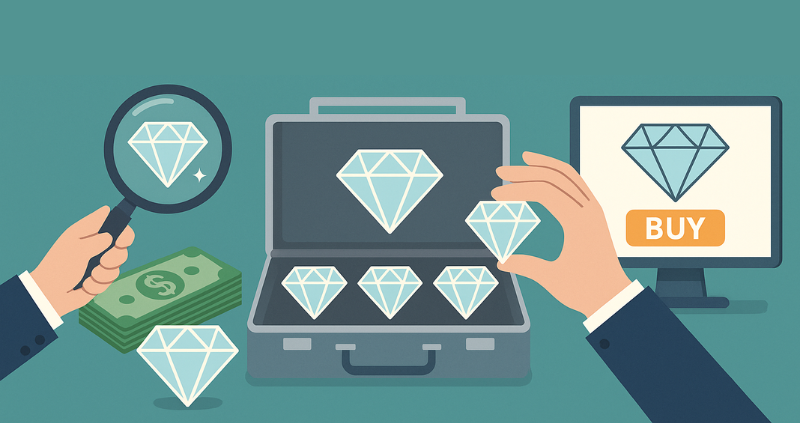From Sourcing to Selling: End-to-End Guide for New Diamond Traders

Starting out in the diamond trade might feel a bit like stepping into an ultra-exclusive club where everyone already knows the secret handshake. But don’t worry every successful trader was once a beginner too. If you’re just getting started, this guide breaks down the entire process from sourcing diamonds to sealing your first sale into bite-sized, manageable steps.
Let’s cut through the clutter and get you trading like a pro!
Step 1: Learn the Basics of Diamond Quality
Before sourcing your first stone, you need to get comfy with the 4Cs:
- Carat (weight)
- Clarity (inclusions and blemishes)
- Cut (how well it reflects light)
- Colour (graded from D to Z)
Understanding these characteristics is crucial — not only do they affect pricing, but they also influence what types of buyers you'll attract.
Tip: Enrol in an online diamond grading course or attend gemology workshops for hands-on experience.
Step 2: Sourcing Your Diamonds
Now that you know what to look for, it’s time to source.
You’ve got three main options:
- Rough Diamonds – Direct from mines or authorized suppliers.
- Polished Diamonds – Through wholesalers, auctions, or online platforms.
- Lab-Grown Diamonds – Often more accessible for beginners due to lower cost and ethical appeal.
Always work with verified suppliers and request certification (GIA, IGI, etc.) to avoid landing counterfeit or conflict diamonds.
Step 3: Get Your Diamonds Cut and Graded
If you’ve sourced rough diamonds, you’ll need to have them cut and polished by a certified cutter. This step can make or break your profit margin.
Then comes grading. Get your diamonds certified by a reputable lab. This increases buyer trust and allows you to price competitively.
Step 4: Prepare for Listing
Whether you're selling online or offline, presentation matters.
- Take high-resolution photos from multiple angles.
- Include details like weight, clarity, cut, colour, certification info, and pricing.
- Use jewellery-specific terms buyers are searching for e.g VVS1 round brilliant cut diamonds.
Pro Tip: Use proper lighting and macro lenses to bring out sparkle in DIY photography.
Step 5: Choose the Right Sales Channels
Now that you’ve got diamonds ready to roll, it’s time to find buyers. Here are a few paths:
- Diamond Bourses (like the Bharat Diamond Bourse)
- Jewellery manufacturers
- Online marketplaces & apps
- Trade shows and exhibitions
- B2B trading platforms
For new traders, digital platforms are often more accessible and offer wider global reach.
Step 6: Build Relationships and Negotiate
Don’t just sell, build long-term relationships with buyers. Communication, transparency, and fair pricing go a long way in earning repeat business.
Be ready to negotiate smartly. Always know your bottom line and market trends before entering discussions.
Step 7: Legal, Shipping & Documentation
Make sure to:
- Follow all customs regulations in your country.
- Use secure, insured shipping methods.
- Keep documentation like invoices, certification, and export-import documents handy.
Stay compliant to avoid delays or penalties.
Wrapping It Up: Your First Trade, Not Your Last
Getting into diamond trading is about strategy, smarts, and strong networks. Once you understand the full journey from identifying a high-quality stone to finding the right buyer you’re already way ahead of the game.

